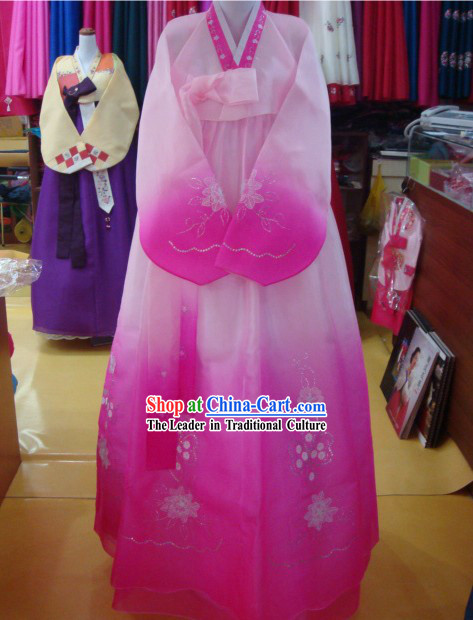Hanbok (South Korea) or Chosŏn-ot (North Korea) is the traditional Korean dress. It is often characterized by vibrant colors and simple lines without pockets. Although the term literally means "Korean clothing", hanbok today often refers specifically to hanbok of Joseon Dynasty and is worn as semi-formal or formal wear during traditional festivals and celebrations. Modern hanbok does not exactly follow the actual style as worn in Joseon dynasty since it went through some major changes during the 20th century for practical reasons.[1]
Throughout history, Korea had a dual clothing tradition, in which rulers and aristocrats adopted different kinds of foreign styles, while the commoners continued to use a distinct style of indigenous clothing that today is known as Hanbok..
other information :
More than three decades ago, hanbok, a traditional form of Korean clothing, was very much a part of every Korean's wardrobe. Like all clothing, hanbok also changed over the years with fluctuating fashion trends. Hanbok designs underwent many changes throughout Korea's turbulent history. The hanbok we wear today are reminiscent of the late Joseon Dynasty (early 20th century).
In traditional hanbok design, curved features are important. As they are not meant to be tight fitting, the inherent beauty of hanbok is apparent in its elegance and style created by the abundance of material. The curves and vibrant colours of hanbok have had a significant impact on the Korean fashion industry. By combining traditional dress with modern fashion, a series of fusion hanbok designs were introduced. Designs and patterns of hanbok have even been applied to architecture.
In traditional hanbok design, curved features are important. As they are not meant to be tight fitting, the inherent beauty of hanbok is apparent in its elegance and style created by the abundance of material. The curves and vibrant colours of hanbok have had a significant impact on the Korean fashion industry. By combining traditional dress with modern fashion, a series of fusion hanbok designs were introduced. Designs and patterns of hanbok have even been applied to architecture.

| [Hanbok in the 16th Century] |
| Although hanbok have become the ritual dress of choice worn only on traditional holidays, Koreans' love for hanbok is tremendous. The popularity of Korean classic dramas is causing many foreigners to take a keener interest in traditional Korean attire as well. |
| [Hanbok in the 16th Century] | |
| 1. Men's hanbok | 2. Women's hanbok |
 |  |
| 3. Children's hanbok | 4. Ceremonial hanbok |
 |  |
| [Headgear and Accessories Worn Together with Hanbok] |
| ||||||||||||||||||||||||||||||||||||
| ||||||||||||||||||||||||||||||||||||
| ||||||||||||||||||||||||||||||||||||
| ||||||||||||||||||||||||||||||||||||
|
I'm more interested in this dress .. seriously!
i think it's very beautiful clothes and showing the features of traditionalcultures represents Korea ..looks decent and interesting.i'm sooo happy if i can wear this clothes...aaaaaarrhh.......
but i still proud to be Malaysian and wear traditional clothes Baju Kurung...
u see....
always looking good in baju kurung..innocent face! haha
if i get married one day, i wanna wear this clothes!


:p
haha...
p/s: to my future yeobo....make sure kamu nk pkai baju tu nnt k!!^_^
bye yeom......
i think it's very beautiful clothes and showing the features of traditionalcultures represents Korea ..looks decent and interesting.i'm sooo happy if i can wear this clothes...aaaaaarrhh.......
but i still proud to be Malaysian and wear traditional clothes Baju Kurung...
u see....
always looking good in baju kurung..innocent face! haha
if i get married one day, i wanna wear this clothes!


:p
haha...
p/s: to my future yeobo....make sure kamu nk pkai baju tu nnt k!!^_^
bye yeom......
















